Guided weapons were first deployed during WWII, most famously by the Germans in the form of the Hs 293 and Fritz-X guided bombs. But the Germans were far from alone in their efforts, and I've also discussed the efforts of the US Army and various other powers to develop air-to-surface guided weapons. However, the weirdest and most interesting program was that of the US Navy, who took a common airframe and build a bewildering array of weapons around it, ranging from the successful to the absurd.
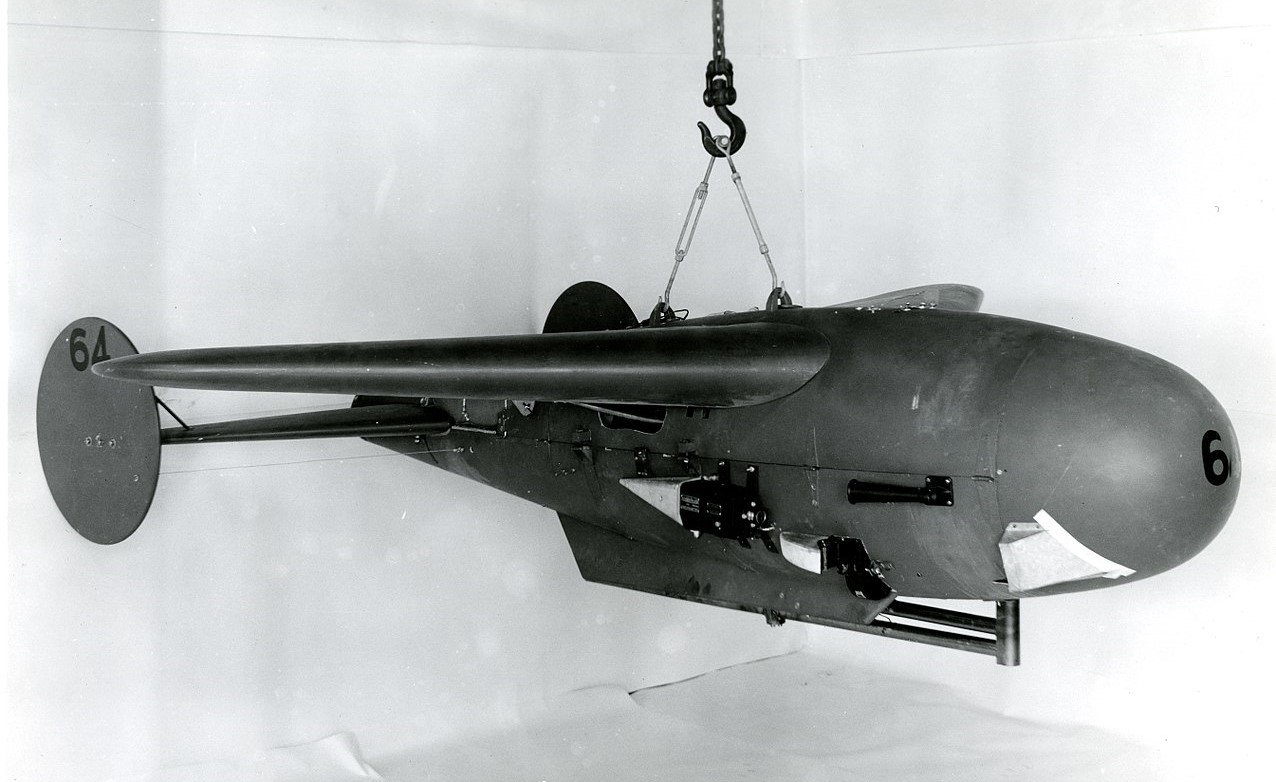
Pelican
The USN's guided weapons program was built around a common airframe developed by the National Bureau of Standards and usually carrying a 1,000 lb warhead, with a wide variety of different guidance systems. The first versions, known as Robin and Dragon, used standard radio guidance, with or without a TV camera to pass images back to the operator. These were not hugely successful, and the program was soon terminated in favor of radar guidance. The first result was Pelican, which would home in on radar signals reflected from a target illuminated by the launching aircraft's radar. After some teething troubles in the guidance system were ironed out, it worked rather well by the standards of the time.1 However, the delay had opened the door for another guidance system, which the Navy decided to put into combat use.2
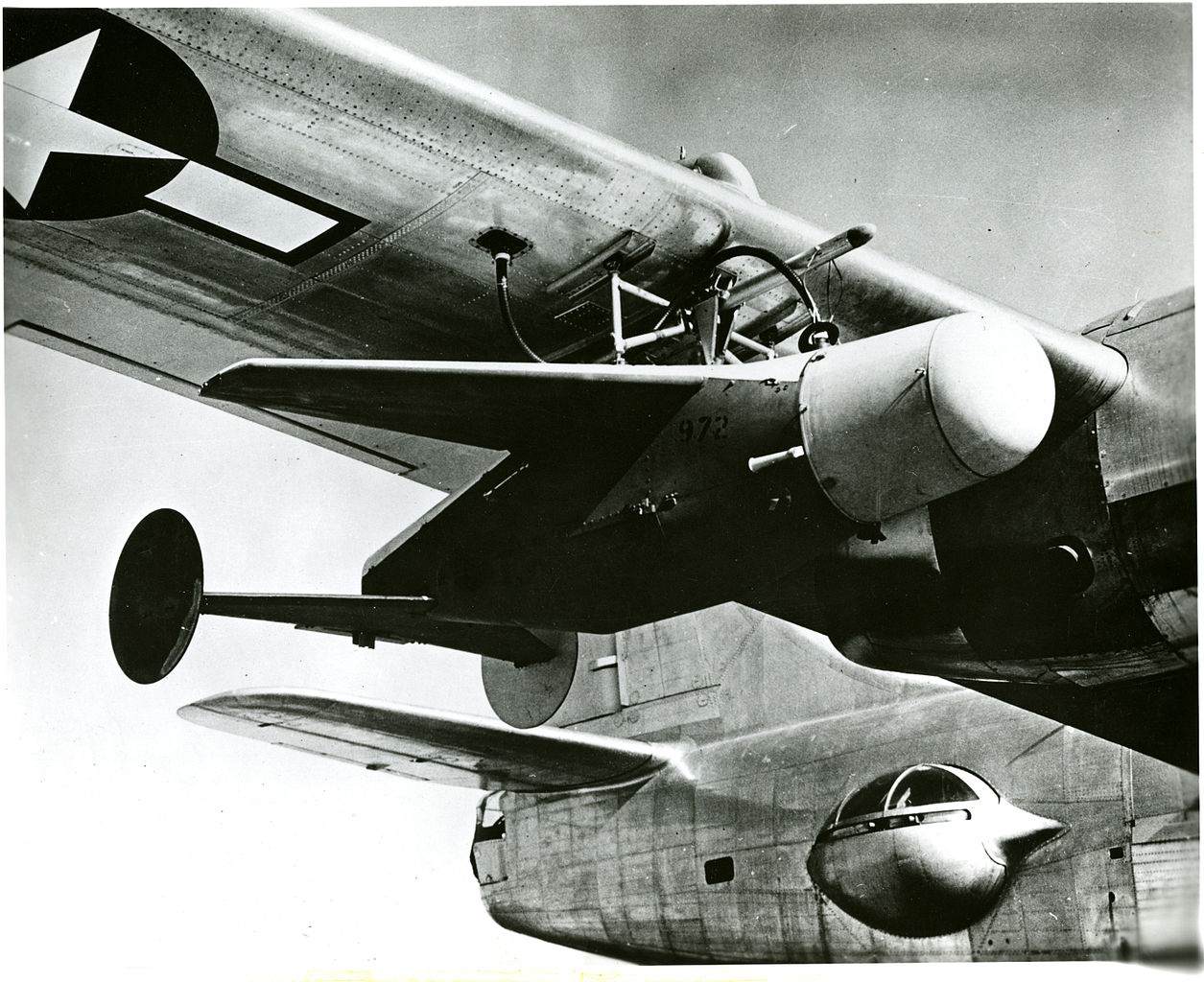
Bat on the wing of a PB4Y-2
The weapon that carried this guidance system was known as Bat, so called because the echolocation capability of that flying mammal was paralleled by its active radar seeker, and it was the first autonomous guided weapon to see operational use. It first sank a ship on April 28th, 1945 off the coast of Borneo. Accuracy during combat was about 50%, not bad for a weapon that could be launched from 25,000' and 20 miles from the target. Many of the misses were because the primitive radar, developed by Bell Labs and MIT, was easily confused by other reflections and tended to decide that pieces of the local landscape were more inviting than the intended target. The primary launch platform, the PB4Y-2 Privateer,3 carried one under each wing, and three squadrons were equipped before the end of the war. The biggest limiting factor in their employment of the weapon was a lack of targets, as the seas had been picked clean by submarines, mines, and conventional aircraft. Postwar, Bat stayed in service until the early 50s, when vulnerability to electronic countermeasures led to its retirement.4
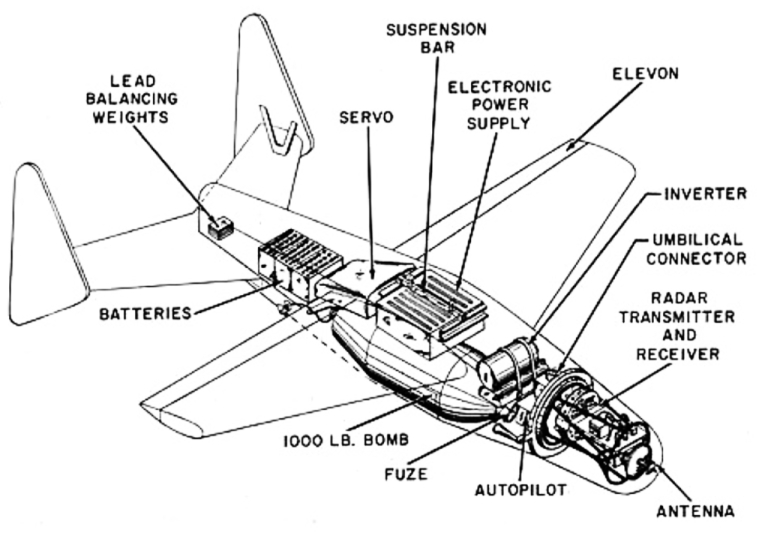
Bat in cutaway
The basic airframe used for Bat proved highly adaptable. By 1944, it was becoming increasingly difficult for torpedo bombers to drop their weapons safely thanks to the thickets of light AA guns sprouting from ships worldwide. While a guided bomb seems like the obvious answer, this wasn't seen as acceptable to the Navy. The bomb was likely to hit well above the waterline, which was not an effective way of achieving a torpedo's basic function of letting water in. Instead, the plan was to shoehorn the torpedo into a standard Bat airframe and guide it close to the target, at which point the torpedo would drop into the water and home in on the target's noise. This also avoided another potential problem with early guided bombs, which is that most of them were relatively slow and vulnerable to being shot down by the target. The guided aerial torpedo program, known as Project Kingfisher, soon spawned six different subvariants, designated Kingfisher A to Kingfisher F.5
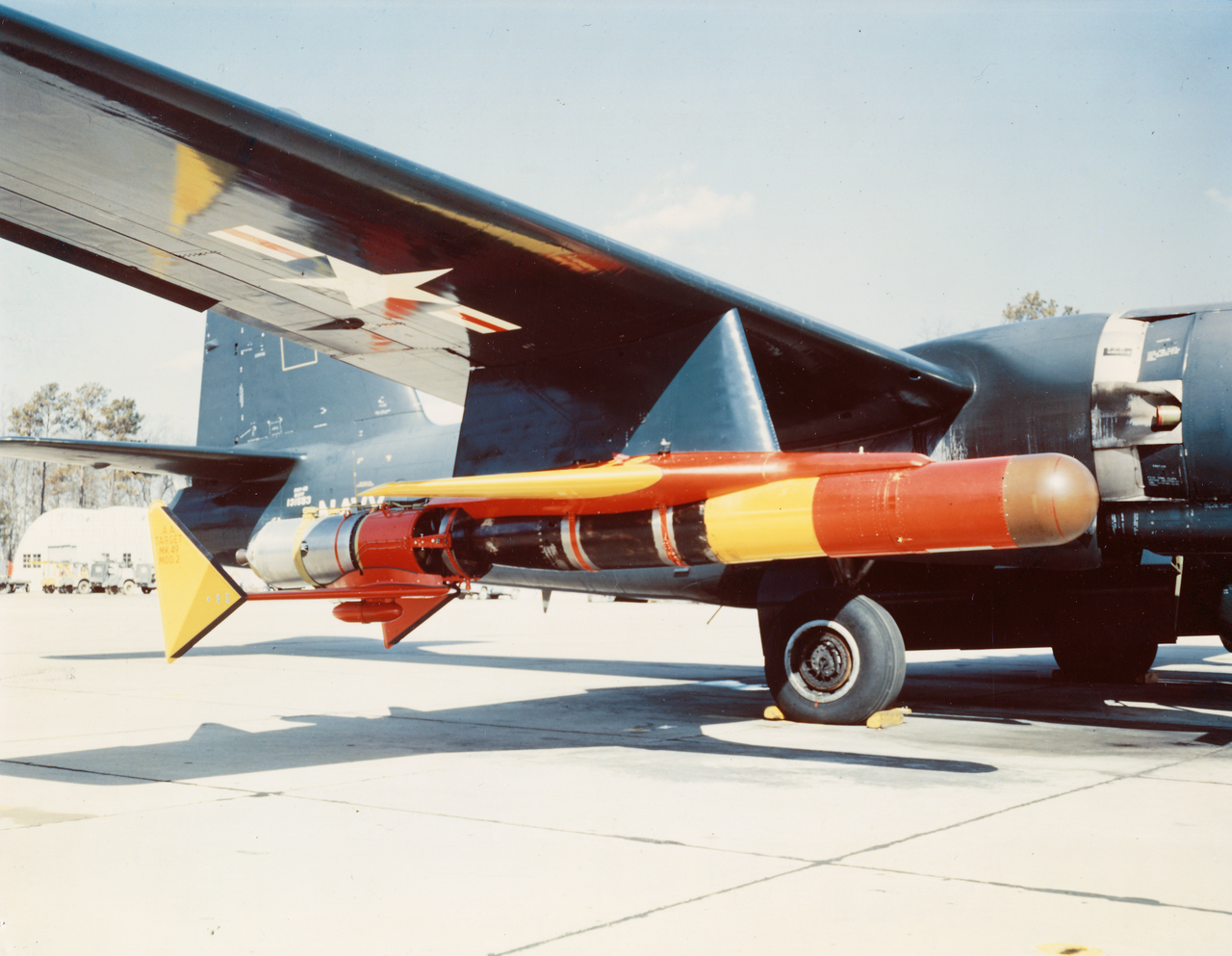
Petrel on the wing of a P2V Neptune
Two of these variants were cancelled fairly quickly, but the other four all saw significant development. The most successful was Petrel, which added a turbojet to the basic design, and was supposed to use semi-active radar homing to guide it close to its target. It's not quite clear whether the weapon, carried by land-based patrol bombers, was intended to attack surface ships or surfaced submarines, but in any case it was retired after only a few years in service, and the remaining Petrels converted to target drones. Less successful was the AUM-N-4 Diver, which was intended to use a single rocket for propulsion both in the air and underwater. In practice, this didn't work very well, and it never entered service. The AUM-N-6 Puffin would replace the torpedo with a plunge bomb, a simple explosive charge designed to drop into the water next to the target, doing similar damage to a torpedo, and mate it with an active radar seeker and a pulsejet engine. It never worked very well although it got somewhat further in development than Diver. The last member of the family, SUM-N-2 Grebe, was intended for launch from surface ships, primarily against submarines. It died when the Navy realized that it grossly outranged contemporary sonars, which sharply limited range against submerged submarines, and that they had little call for such a system to attack other surface ships or surfaced submarines, although the basic concept would return a few years later in the form of ASROC.

B.F. Skinner
The standard airframe was also considered for by far the oddest guidance system of the war: pigeons. The unimaginatively-named Project Pigeon was the brainchild of behaviorist B.F. Skinner. Pigeons were trained to peck at the image of a ship, and then placed into the guidance section of the bomb. The image was projected onto a screen, and so long as the bomb was on course, the target would appear at the center of the screen. If it drifted off course, the pigeon would continue to peck, tilting the screen and commanding the bomb's controls to deflect and correct the weapon's trajectory. Even weirder than the concept is the fact that it apparently worked reasonably well, with the pigeons being trained to do their job perfectly despite Skinner's best attempts to distract them with centrifuges, gunshots, and the effects of high altitude. Unfortunately for lovers of military absurdity, but fortunately for the pigeons, the Navy cancelled the project in 1944 before the system was tested in flight. For some reason, the concept was revived four years later, and the second version, named OrCon from ORganic CONtrol, spent five years verifying that pigeons could indeed be used to guide a weapon, although it was cancelled in the face of improvements in electronic guidance systems without, so far as I know, actually dropping pigeons in a live test.
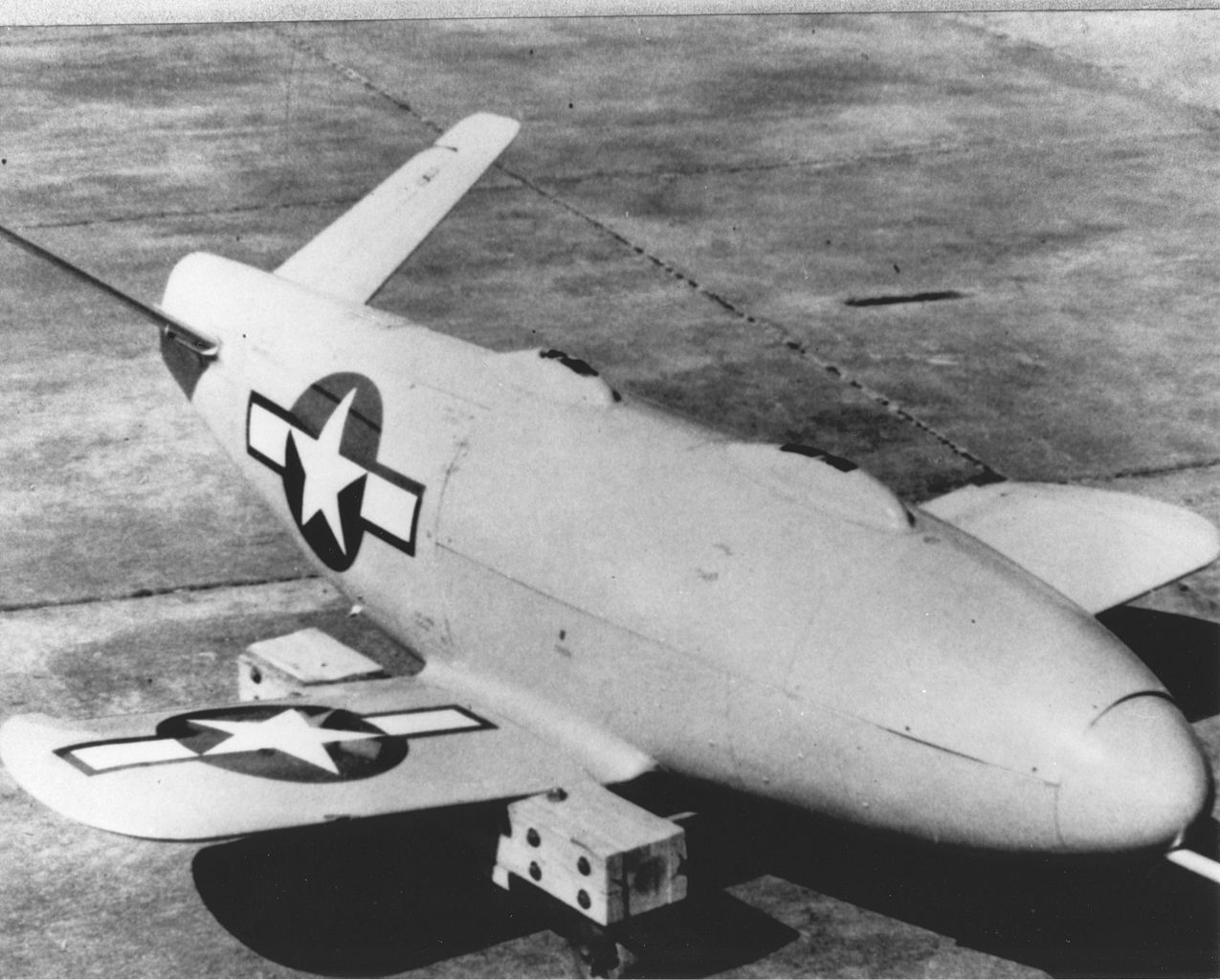
LBD-1 Gargoyle
One last USN missile, not based around Bat, that deserves mention is Gargoyle. This was a fairly simple radio-guided anti-ship weapon, but one designed to be carried and used by carrier aircraft instead of land-based bombers. It was also fitted with a rocket that could propel it to 600 mph, a speed at which its armor-piercing 1000-lb bomb could do serious damage to the target ship. It was the first serious product of McDonnell Aircraft, and a few hundred were built before the program was shut down in 1950.
The first years of the guided missile were a weird and wild time, with all sorts of guidance systems being examined. Some were complete busts, while others worked well enough and a few became so successful that their descendants are still in use today, but all of them show incredible ingenuity as engineers pushed the bounds of what the technology of the day could do.
1 One 1944 test saw 2 out of 4 bombs hit a target ship, which would have been near-miraculous for a weapon that allowed that kind of standoff. ⇑
2 Another variant of Pelican, known as Moth, had its guidance system altered to home in on radar transmitters, possibly the first anti-radiation missile. Some sources also indicate that there was a version of Pelican that carried a depth charge instead of the 1000 lb general-purpose warhead. ⇑
3 The PB4Y-2 was a stretched, single-tailed variant of the famous B-24 Liberator. ⇑
4 For more information on Bat, see this excellent website. ⇑

Comments
What makes Project Pigeon extra hilarious to me is that B.F. Skinner ~basically~ thought he'd solved all of psychology with pigeon-training experiments.
They ran pulsejets at mach 0.7?
Wouldn't a subsonic ramjet be better suited to those conditions? Use a solid rocket to boost it up to mach 0.5 or so first.
Keep in mind that this was the late 40s, when a lot of high-speed aerodynamics were being worked out. Lots of crazy solutions were being tried, and nobody knew how they'd work out. For all I know (details on this kind of stuff are sketchy) they went with a pulsejet to try to keep the cost down.
I realize that TV was very new in the 40s, but I've always been surprised at the general lack of TV guided bombs. If the pigeon can peck at the image of a ship, I'd think a human operator could do the same to the broadcast image of a ship. Were early cameras just to heavy/expensive/insufficiently robust for that to work out?
That would be my guess. Between the camera, the datalink back to the plane, and the receiving gear on the plane, you're looking at a bunch of delicate and expensive electronics, and it's probably easier to just put a flare in the tail of the bomb and have the operator eyeball it.
Kingfisher A to Kingfisher E is only five variants. Did you mean A to F?
I did, yes. Oops.
The tv signal back to the operator is probably a lot more jammable than the control signal.
Since there's so much more data going across and you have to fit the transmitter on a bomb.
I'm mostly just surprised that the tv-guided rpg from the old James Bond Nightfire game I played as a kid is kinda sorta grounded in actual technology.
That's a good point. There are TV-guided weapons, but they mostly didn't show up until the 60s. In WWII, I'm pretty sure that the pigeon would be more reliable.
Except, that is, for getting confused. The one thing I never saw tested in the accounts I read was target discrimination. Would one pigeon get confused by multiple ships? What about a multi-pigeon system? How could you be sure they'd all go after the same ship? How would you even train for that?